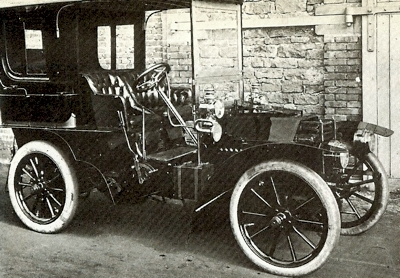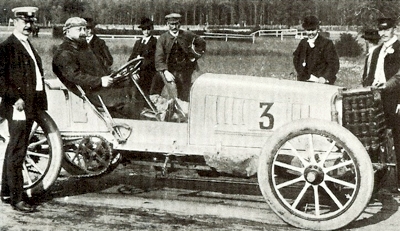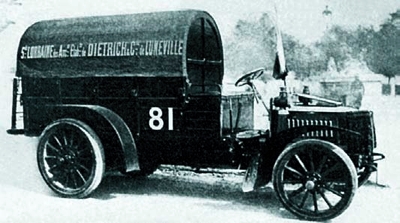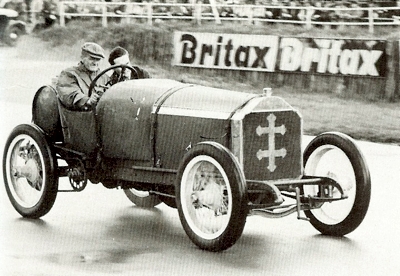|
De Dietrich
|
1896
- 1935 |
Country: |
 |
|
They called it the Societe Lorraine des Anciens Etablissements de Dietrich & Cie: and the Etablissements really were anciens, as the company had been founded as long ago as 1684 by Jean de Dietrich.
By the time it became interested in motor-manufacture in the 1890s, the company was mainly concerned with the production of railway rolling stock. It was still under family control, though the Franco-Prussian war of 1870 had left their two manufacturing plants, at Luneville (Lorraine) and Niederbronn (Alsace), in two different countries.
In charge of the Luneville operation was the Baron Adrien deTurckheim, who acquired manufacturing rights to a design by Amedee Bollee Jr in 1896. These Bollee-Dietrich cars were chiefly remarkable for their transmission: a horizontal- twin engine drove, by belt, a sliding gear box, with clutch action achieved by loosening the belts; from the transverse countershaft incorporating the differential, propeller shafts took the drive to each rear wheel. Spiral bevel gears were used at either end of the propeller shafts; it was the first time this form of gearing had been employed in a car.
At first, Bollee built the engines, while De Dietrich made the rest of the vehicle. Soon, however, the entire car was being produced at Luneville, The next major development was the construction of the four-cylinder, independent-front-suspension Bollee Torpilleur racing cars. These made a notable showing in the 1898 Paris-Amsterdam trials, in which Gaudry's car finished third, despite a crash en route.
The performance of the cars aroused such enthusiasm that, during the weeks following the Paris-Amsterdam event, De Dietrich received orders totalling more than a million gold francs. One customer, the Comte de Paiva, commissioned what must have been one of the world's first streamlined sports cars; its coachwork by Rheims & Auscher incorporated a raked windscreen.
However, the next joint venture of Bollee and De Dietrich, the advanced torpilleur of 1899, with underslung chassis and rear-mounted four-cylinder mono-block engine with twin carburetors was less successful due to insufficient preparation, and none of the works team completed the Tour de France race for which it had been designed. Despite pressure from Turckheim, Bollee decided to withdraw from competition and, though the Bollee-Dietrichs survived into the new century, latterly with chain drive, they were soon replaced in production by a neat little voiturette built under licence from Vivinus of Belgium in the Niederbronn factory, and by the Marseilles-designed Turcat-Mery at Luneville.
Looking around for a car to replace the voiturette from Niederbronn, Eugene de Dietrich saw a neat four-cylinder, four-speed car which had been designed by the 19 year-old Ettore Bugatti, financed by the Count Gulinelli; the vehicle had won an award from the Automobile Club of France in 1899, and a gold medal at the Milan Exhibition of 1901. By 1902, Bugatti was on the pay roll at Niederbronn and had designed a 24 hp, four-speed, four-cylinder model with overhead-valves operated by pull-rods.
Bugatti produced a second model towards the end of 1903, a 30/35 hp De Dietrich; both the 24/28 and the 30/35 were marketed in Britain by the Burlington Carriage Co, who also handled the products of Luneville. However, the Niederbronn cars were sometimes sold as Burlingtons, while the Luneville cars always retained the De Dietrich label (sometimes suffixed by Turcat-Mery). Though Bugatti left De Dietrich in 1904 to join Mathis at Strasbourg, where he designed the Hermes car, Burlington kept up their association with him, selling the 40 hp Bugatti-Hermes alongside the De Dietrichs in 1905. This was the result of Niederbronn's decision to leave car production to Luneville; from the end of 1904, the Alsatian market was su pp lied with Turcat - Merys (the genuine Marseill- aise item) imported by Mathis and fitted with De Dietrich badges.
 1902 DeDietrich, based on a Turcat Mery design. Turcat Mery were short of capital, and so signed an agreement with De Dietrich to design cars for them in 1901.
1902 DeDietrich, based on a Turcat Mery design. Turcat Mery were short of capital, and so signed an agreement with De Dietrich to design cars for them in 1901.
 de Dietrich at the wheel of one of his 1903 model racers.
de Dietrich at the wheel of one of his 1903 model racers.
 1905 De Dietrich 2 Tonne Truck - Army version.
1905 De Dietrich 2 Tonne Truck - Army version.
 Luneville renamed its cars Lorraine-Dietrich as a mark of independence. Note the cross of Lorraine on the radiator of this 1912 15 liter version.
Luneville renamed its cars Lorraine-Dietrich as a mark of independence. Note the cross of Lorraine on the radiator of this 1912 15 liter version. |
Lorraine-Dietrich
To emphasise their independence from this arrangement, Luneville soon renamed their cars Lorraine-Dietrich; they carried the cross of Lorraine on their radiator as an indication of their French nationality. Behind their impressive new radiator, the Luneville cars were still Turcat-Merys - and remained so until 1911 - though they had little in common with the range of four models (8 hp-twin and 12, 16 and 24hp- fours) which had begun the association in 1902.
Charles Jarrott & Arthur Duray
The Lorraine-Dietrichs were handsome machines, with a reputation as one of the top half-dozen quality marques, ranking with cars such as Itala and Crossley. Around 1905-8, they even built a handful of super-luxury six-wheeled cars, at costs up to (UK) £4000 for a limousine de voyage. In part, the marque's reputation was built on its competition record, which was consistent if not distinguished: highlights included third place for Charles Jarrott in the 1903 Paris-Madrid, and a 1-2-3 victory in the 1906 Circuit, des Ardennes for the star works driver Arthur Duray.
Apart from the smallest model, the 14hp, all the 1908 De Dietrich touring cars were chain-driven, the range consisting of four fours-18/28 hp, 28/38 hp, 40/45hp and 60/80hp-priced between £550-£960, and a monstrous 70/80hp six at a chassis price of £1040. By now, the company was flexing expansionist muscles and, in 1907, had signed an agreement with Isotta-Fraschini in which they acquired control of the Milanese company; the cars built during this period of association, which ended in 1911, included two overhead-camshaft cars, the smaller of which was the 1.4- liter, 10 hp model apochryphally credited to Ettore Bugatti.
The British Lorraine-Dietrich
In 1907, the Lorraine-Dietrich company bought the factory of Ariel Motors Limited of Birmingham to produce a British Lorraine-Dietrich. One model only was made: a four-cylinder, 20 hp car which made its debut at the 1908 Olympia Motor Show, where three items-a polished chassis, a Mulliner cabriolet and a convertible by Salmons were exhibited. The British cars differed from their French counterparts only by having shaft instead of chain drive and were marketed through the same sales organisation, Charles Jarrott & Letts of London. It was a venture which lasted only a year or so, and resulted in a loss for the parent company.
The Lorraine-Dietrich line-up in the immediate pre-war period consisted of three quality touring cars, a 12/16, an 18/20 and a new 20/30, plus a 40/75 four-cylinder, semi-racing model; the entire range was now shaft -driven. By now, production was concentrated at the company's new factory at Argenteuil, Seine-et-Oise, which became the company's headquarters after World War 1. In 1919, the company's new technical director, Marius Barbarou, produced the first post-war model, the 15 hp. As Barbarou had come to Lorraine-Dietrich from Delaunay-Belleville, the new car was naturally a six-cylinder, and was originally made in two wheelbase types, the A1-6 and the B2-6.
In 1922, a further development, the B3-6, appeared with a choice of short or long-wheelbase chassis. The 15 hp had a swept volume of 3.4 liters, with overhead-valves in hemispherical heads, a four-bearing crankshaft and aluminum pistons. Barbarou's original intention was to produce a moderately priced touring car of quality, but it soon became apparent that the performance of this model was worthy of a sporting variant. This fact was underlined in 1923, when a team of three touring Lorraines put up a passable showing in the first Le Mans 24-hour race.
The Silken Six
For the 1924 event, Barbarou designed the 15 Sport, with twin carburetors, oversize valves and four-wheel braking with Dewandre-Reprusseau servo assistance; the cars took second and third places and established themselves as the French equivalent of the 3-liter Bentley. In 1925, the 15 Sport of Courcelle and Rossignol took first place at Le Mans, with a sister car in third position. The next year was even better: Bloch and Rossignol came first at an average speed of 66 mph, a record speed for the event, with Lorraines in second and third positions. In the reflected glory of these sporting achievements, the touring 15 hps - known in Britain as 'The Silken Six' - acquired a new glamour.
The undistinguished coachwork of the earlier models was replaced by more stylish bodies, mostly from the firm of Gaston Grummer, who was also commercial director at Argenteuil; his products bore such names as Gloriosa, Aurora, Olympia, Gloria and Chiquita. Alongside the 15hp were sold two other touring models, the four-cylinder 12 hp ('agreable et pratique') and the 30 hp six. The larger model lasted until 1927, while the smaller continued until 1929.
As for the 'ilegan: et inimitable' 15 hp, it survived in production until 1932, when it was succeeded by a new 20 hp, four-liter model; the 15 Sport had been discontinued in 1930, and had just missed ending its distinguished career with one final victory when the 22-year-old Jean-Pierre Wimille had lost the 1931 Monte Carlo Rally by one-tenth of a decimal point to Donald Healey's Invicta. Only a few hundred of the elegant 20 hp models were built, and sales were far from encouraging. The model's effective production life was only a couple of years, and by 1935 the name of Lorraine-Dietrich had vanished from the motor industry.
After 1930, the company formed part of the Societe Generale Aeronautique, a consortium of aircraft manufacturers, and Argenteuil went over to the manufacture of aero engines and military six-wheelers built under licence from the Czech firm of Tatra. As for Luneville, once it had ceased to be a centre of car production, it reverted to its former ways, and was in business up to the 1970's as a manufacturer of railway ironmongery.
